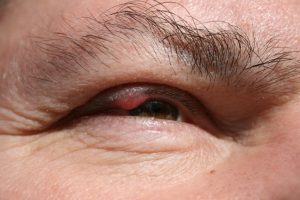
There are four main types of blepharitis: anterior, posterior, mixed, and rosacea blepharitis.
Anterior blepharitis is characterized by inflammation on the outside of the eyelid where the eyelashes are attached. The cause is usually bacterial or, in some cases, viral.
Posterior blepharitis is a dysfunction of the eye’s oil glands located in the eyelids at the base of the eyelashes. Clogging of the glands can result in thickened eyelid margins and crusty eyelids.
Mixed blepharitis is when anterior and posterior types occur at the same time.
Lastly, rosacea blepharitis is associated with ocular rosacea, which causes swelling and redness of the eyelids.
Causes of blepharitis
Blepharitis as a condition is not fully understood, but generally the cause depends on the type of blepharitis. Therefore, common causes of blepharitis are bacterial or viral infections, dry eye syndrome, malfunctioning oil glands in the eyelid, and ocular rosacea.
Symptoms and complications of blepharitis
- Watery eyes
- Red eyes
- A gritty, burning, or stinging sensation
- Greasy-looking eyelids
- Red, swollen eyelids
- Flaking of the skin around the eyes
- Crusted eyelids upon awakening
- Eyelids that stick together
- Frequent blinking
- Light sensitivity
- Abnormally growing eyelashes
- Loss of eyelashes
Complications resulting from blepharitis include eyelash problems, eyelash loss, eyelid skin problems, excessive tearing or dry eyes, difficulty wearing contact lenses, formation of a stye or chalazion, chronic pink eye, and injury to the cornea.
Treatment and diagnosis of blepharitis
To diagnose blepharitis, your doctor will examine your eyelids and swab the skin to be tested. The doctor will also swab the oil or crust to be analyzed for the presence of bacteria and fungi, or for evidence of an allergy.
Treatment includes medication for any present infections, antibiotics directly applied to the eyelid or as eye drops, medications to control inflammation, medications to control the immune system, and treatments to address any other underlying issue.
It’s important to note that even with prescribed treatment blepharitis rarely completely goes away, as it’s often a chronic condition. It is up to you to take the necessary steps to keep it under control to prevent a flare-up.
Eyelid hygiene to prevent blepharitis
- Apply warm compresses along the outer eyelids
- Cleanse the eyelids with a recommended scrub
- Always ensure your hands are clean when touching or cleaning your eyes
- Avoid wearing eye makeup if your eyelids are inflamed
- Keep your eyes lubricated to prevent dry eyes
- Control dandruff with a specialty shampoo
By following these steps and your doctor’s instructions, you can have greater success in preventing blepharitis.